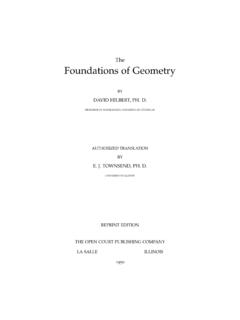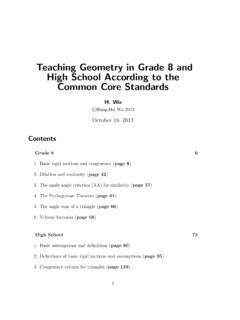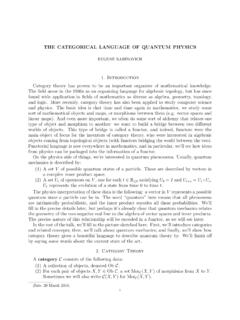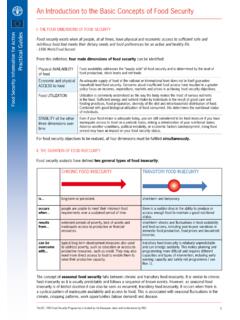Transcription of An Introduction to String Theory - UCB Mathematics
1 Preprint typeset in JHEP style - PAPER VERSIONR evised May 6, 2011An Introduction to String TheoryKevin WrayAbstract:This set of notes is based on the course Introduction to String Theory which was taught by Prof. Kostas Skenderis in the spring of 2009 at the Universityof Amsterdam. We have also drawn on some ideas from the booksString Theory andM- Theory (Becker, Becker and Schwarz), Introduction to String Theory (Polchinski), String Theory in a Nutshell(McMahon) andSuperstring Theory (Green, Schwarz andWitten), along with the lecture notes of David Tong, sometimes Motivation for String What is String Types of String Outline of the Manuscript92. The Bosonic String Classical Action for Point Classical Action for Relativistic Point Reparametrization Invariance of Canonical Varying S0in an Arbitrary Background (Geodesic Equation) Generalization to The String Exercises243.
2 Symmetries and Field Equations of the Bosonic Global Symmetries of the Bosonic String Theory Local Symmetries of the Bosonic String Theory Field Equations for the Polyakov Solving the Field Exercises424. Symmetries (Revisited) and Canonical Noether s Method for Generating Conserved The Hamiltonian and energy -Momentum Classical Mass Formula for a Bosonic Witt Algebra (Classical Virasoro Algebra) Canonical Quantization of the Bosonic Virasoro Physical Exercises62 1 5. Removing Ghost States and Light-Cone Spurious Removing the Negative Norm Physical Light-Cone Gauge Quantization of the Bosonic Mass-Shell Condition (Open Bosonic String ) Mass Spectrum (Open Bosonic String ) Analysis of the Mass Exercises796.
3 Introduction to Conformal Field Conformal Group Conformal Algebra in 2 (Global) Conformal Group in 2 Conformal Field Theories in d Constraints of Conformal Invariance in d Conformal Field Theories in 2 Constraints of Conformal Invariance in 2 Role of Conformal Field Theories in String Exercises947. Radial Quantization and Operator Product Radial Conserved Currents and Symmetry Operator Product Expansion (OPE) Exercises1058. OPE Redux, the Virasoro Algebra and Physical The Free Massless Bosonic Charges of the Conformal Symmetry Representation Theory of the Virasoro Conformal Ward Exercises1279. BRST Quantization of the Bosonic BRST Quantization in BRST Quantization: A BRST Ward BRST Cohomology and Physical BRST Quantization of the Bosonic String140 2 The Ghost BRST Current and Vacuum of the BRST Quantized String Ghost Current and Exercises15610.
4 Scattering in String Vertex Exercises16011. Supersymmetric String Theories (Superstrings) Ramond-Neveu-Schwarz Global Worldsheet Supercurrent and the Super-Virasoro Boundary Conditions and Mode Open RNS Closed RNS Canonical Quantization of the RNS Superstring R-Sector Ground State VS. NS-Sector Ground Super-Virasoro Generators (Open Strings) and Physical States Physical State Removing the Ghost Light-Cone Open RNS String Mass GSO Closed RNS String Exercises19312. T-Dualities and T-Duality and Closed Bosonic Mode Expansion for the Compactified Mass T-Duality of the Bosonic T-Duality and Open Mass Spectrum of Open Strings on Branes in Type II Superstring Dirac-Born-Infeld (DBI) Exercises214 3 13.
5 Effective Actions, Dualities, and Low energy Effective Conformal Invariance ofS and the Einstein Other Couplings of the Low energy Effective Action for the Bosonic String Low energy Effective Action for the Superstring T-Duality on a Curved S-Duality on the Type IIB Superstring Brane Solutions of Type IIB Action of the Brane Solutions Under the Duality Exercises24314. Black Holes in String Theory and the AdS/CFT Correspondence Black Classical Theory of Black Quantum Theory of Black Black Holes in String Five-Dimensional Extremal Black Holographic The AdS/CFT Correspondence255A. Residue Theorem260B. Wick s Theorem261C. Solutions to Exercises262 4 1.
6 Motivation for String TheoryPresently we understand that physics can be described by four forces: gravity, elec-tromagnetism, the weak force, responsible for beta decays and the strong force whichbinds quarks into protons and neutrons. We, that is most physicists, believe that weunderstand all of these forces except for gravity. Here we use the word understand loosely, in the sense that we know what the Lagrangian is which describes how theseforces induce dynamics on matter, and at least in principle we know how to calculateusing these Lagrangians to make well defined predictions. But gravity we only under-stand partially. Clearly we understand gravity classically (meaning in the~= 0 limit).
7 As long as we dont ask questions about how gravity behaves at very short distances(we will call the relevant breakdown distance the Planck scale) we have no problemscalculating and making predictions for gravitational interactions. Sometimes it is saidthat we don t understand how to fuse quantum mechanics and GR. This statementis really incorrect, though for NY times purposes , it s fine. In fact we understandperfectly well how to include quantum mechanical effects into gravity, as long we wedont ask questions about whats going on at distances, less than the Planck length. Thisis not true for the other forces. That is, for the other forceswe know how to includequantum effects, at all distance , while we have a quantum mechanical understanding of gravity, we don t havea complete Theory of quantum gravity.
8 The sad part about thisis that all the reallyinteresting questions we want to ask about gravity, what s the big bang , whathappens at the singularity of black hole, are left unanswered. What is it, exactly, thatgoes wrong with gravity at scales shorter than the Planck length? The answer is, itis not renormalizable . What does renormalizable mean?This is really a technicalquestion which needs to be discussed within the context of quantum field Theory , butwe can gain a very simple intuitive understanding from classical electromagnetism. So,to begin, consider an electron in isolation. The total energy of the electron is given byET m+ d3x|~E|2 m+ 4 r2dre2r4.( )Now, this integral diverges at the lower endpoint ofr= 0.
9 We can reconcile thisdivergence by cutting it off at some scale and when were done well see if can take thelimit where the cut-off goes to zero. So our results for the total energy of an electronis now given byET m+Ce2 .( ) 5 Clearly the second term dominates in the limit we are interested in. So apparently evenclassical electrodynamics is sick. Well not really, the point is that weve been rathersloppy. When we write mwhat do we mean? Naively we mean what we would callthe mass of the electron which we could measure say, by looking at the deflection ofa moving electron in a magnetic field. But we dont measure m, we measureET, thatis the inertial mass should include the electromagnetic self- energy .
10 Thus what reallyhappens is that the physical massmis given by the sum of the bare mass mand theelectrons field energy . This means that the bare mass is infinite in the limit wereinterested in. Note that we must make a measurement to fix the bare mass. We cannot predict the electron also means that the bare mass must cancel the field energy tomany is we have two huge numbers which cancel each other extremely precisely! Tounderstand this better, note that it is natural to assume that the cut-off should be,by dimensional analysis, the Planck length (note: this is just a guess). Which in turnmeans that the self field energy is of order the Planck mass. Sothe bare mass musthave a value which cancels the field energy to within at the level of the twenty seconddigit!














